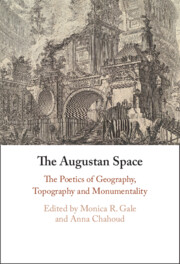Book contents
- The Augustan Space
- The Augustan Space
- Copyright page
- Contents
- Notes on Contributors
- Preface
- Abbreviations
- Introduction
- Chapter 1 The City in Horace’s sermo
- Chapter 2 excucurristi a Neapoli
- Chapter 3 Poetic and Imperial Spaces in Propertius, Books 1–3
- Chapter 4 Horace on Sacred Space
- Chapter 5 Roman Topography, Politics and Gender
- Chapter 6 aurea nunc, olim siluestribus horrida dumis
- Chapter 7 Hippolytus and Egeria in the Woods of Aricia (Virgil, Aen. 7.761–82 and Ovid, Met. 15.479–551)
- Chapter 8 locum tua tempora poscunt
- Chapter 9 imperii Roma deumque locus
- Chapter 10 The Rise and Fall of Virgil’s Sublime Carthage
- Chapter 11 Eccentric Poetry
- Chapter 12 Virgilian Heterotopias
- Chapter 13 loci desperati
- Works Cited
- Index Locorum
- General Index
Chapter 2 - excucurristi a Neapoli
Virgil, Augustus and the Art of Disappearing
Published online by Cambridge University Press: aN Invalid Date NaN
- The Augustan Space
- The Augustan Space
- Copyright page
- Contents
- Notes on Contributors
- Preface
- Abbreviations
- Introduction
- Chapter 1 The City in Horace’s sermo
- Chapter 2 excucurristi a Neapoli
- Chapter 3 Poetic and Imperial Spaces in Propertius, Books 1–3
- Chapter 4 Horace on Sacred Space
- Chapter 5 Roman Topography, Politics and Gender
- Chapter 6 aurea nunc, olim siluestribus horrida dumis
- Chapter 7 Hippolytus and Egeria in the Woods of Aricia (Virgil, Aen. 7.761–82 and Ovid, Met. 15.479–551)
- Chapter 8 locum tua tempora poscunt
- Chapter 9 imperii Roma deumque locus
- Chapter 10 The Rise and Fall of Virgil’s Sublime Carthage
- Chapter 11 Eccentric Poetry
- Chapter 12 Virgilian Heterotopias
- Chapter 13 loci desperati
- Works Cited
- Index Locorum
- General Index
Summary
The inclination to withdraw himself from the public as far as possible is regarded as one of Virgil’s most salient characteristics: this at least is the impression given by the few testimonia and numerous anecdotes of his life. The guiding principle of Virgil’s life as a poet of the res publica Romana could be described as an ‘art of disappearing’, which becomes evident in different ways. By means of this Virgil sometimes succeeds in withdrawing himself spatially even from Augustus, the mightiest designer of space, and in establishing certain limits to his ‘topotactic’ power. To present the ‘withdrawing technique’ practised by Virgil, this chapter draws on information gathered from biographical texts on Virgil as well as on relevant passages of Virgil’s work, naturally without ignoring the documentary fragility of the texts considered. Nevertheless there are conspicuous correspondences between the texts about Virgil and the poetological messages within his literary works, which give an impression at least of his effective seclusion. His reception by his contemporaries and immediate successors proves his greatest success in this respect.
- Type
- Chapter
- Information
- The Augustan SpaceThe Poetics of Geography, Topography and Monumentality, pp. 41 - 52Publisher: Cambridge University PressPrint publication year: 2024



